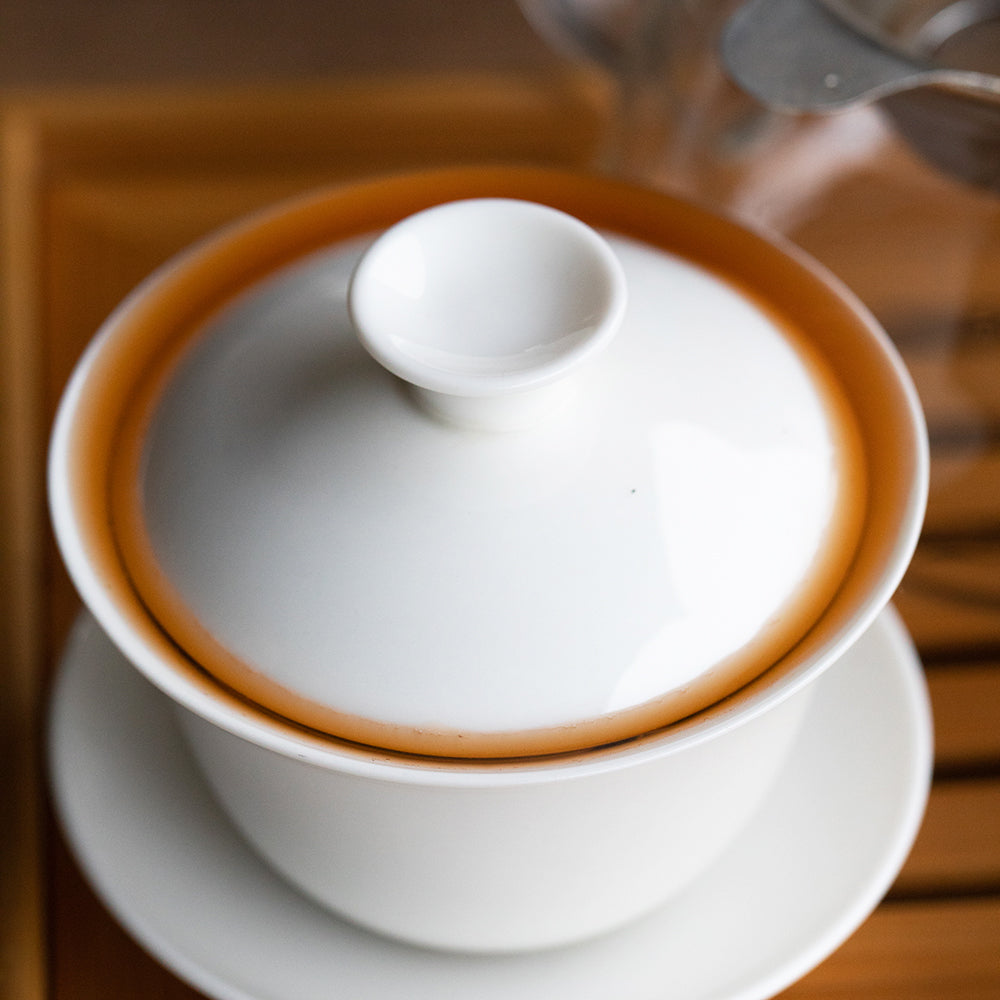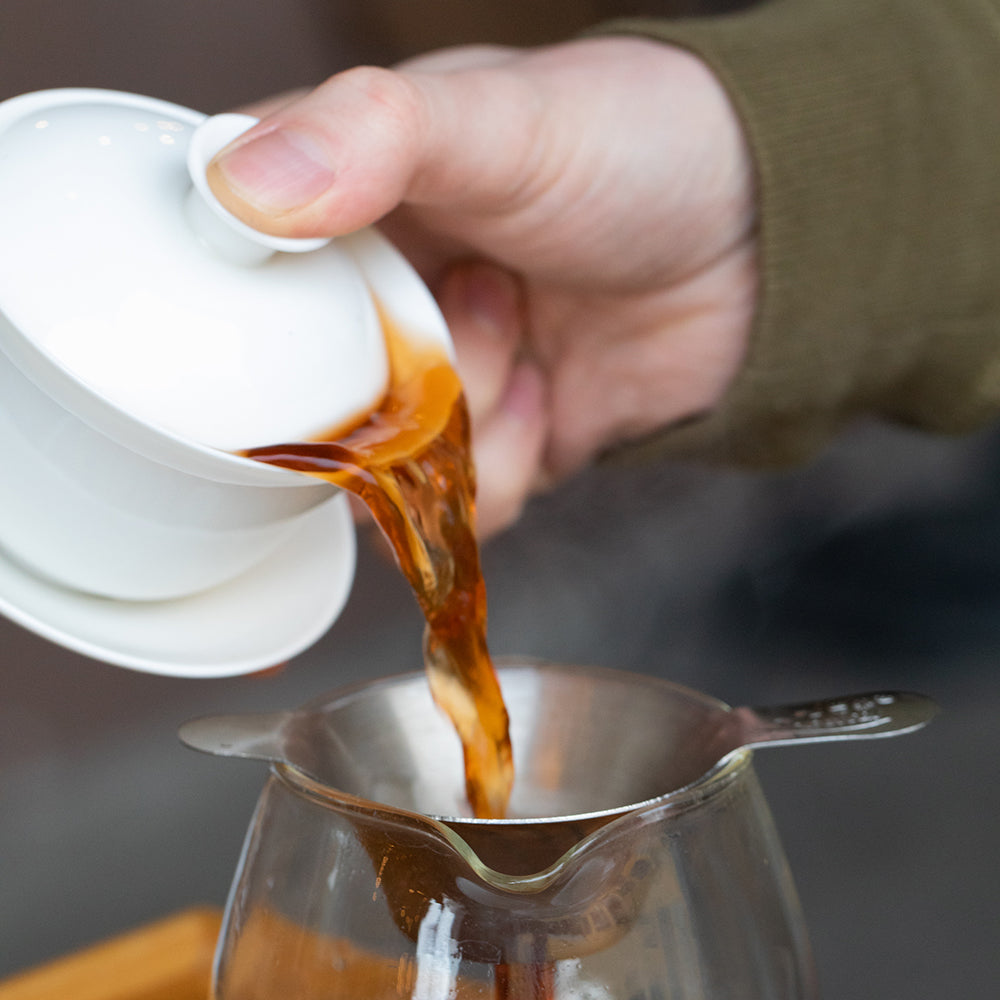In Chinese, Gaiwan translates to lidded bowl. Often simple, with a few accoutrements, a Gaiwan Set provides the least barrier between tea and human. The simplicity of the gaiwan is complemented by the skill and knowledge gained with such a personal experience with the tea of your choice. There is some practice involved, as the liquid and the gaiwan tend to be quite hot and the short and successive steepings require some artistry and technique.



What is Gaiwan Service?
It is the preparation of select teas in a more traditional Chinese or Taiwanese way. Unlike Western style steeping where a minimal amount of tea is used in a larger teapot, steeping in a gaiwan flips this ratio, with much more leaf being used then would be expected for such a small vessel.
Traditionally the first extraction, often referred to as rinsing the leaves, is only brewed for a few seconds before it is discarded. This is followed by a short steep of 10-20 seconds, which is then poured through a filter into a glass pot. This allows for an even distribution of the steep, which is then served into the teacups. The gaiwan then can be refilled with hot water for the next steeping, while adding 5-10 seconds to this and each consecutive steep. Since the steep time is so short you can get multiple extractions (which is dependent on the tea and other variables like water temperature or steep time).

Why use a gaiwan?
It is the perfect way to experience the true character of many single origin teas, with each steep providing a different experience of the tea in its flavor, body and finish. Teas stay fragrant, sweet and retain structure when prepared well. Almost every type of tea can be enjoyed this way - oolongs, pu-erhs, green tea (Chinese not Japanese), white tea and black tea.
What is the difference between Gaiwan and Gong Fu?
In a simple translation, Gong Fu means to make or perform with skill (it is related to how Kung Fu is a mastery of Martial Arts). Over time, Gong Fu in the tea world has evolved into a tea experience that involves a mastery of tea and vessel to elicit the most out of the leaves. Although the terms can be interchangeable at times, we decided to use the term Gaiwan in reference to the lidded pot being used.

Which teas work best in a Gaiwan?
While any tea can be prepared in this fashion, not all leaf styles perform best using this technique. At Smith, we recommend the following teas as part of this service:
Golden Oolong - Grown high at the edge of Western China using the famous Green Heart cultivar from Taiwan, this masterfully oxidized oolong brings notes of honey, malt and toasted coconut that make it a dark and rare delight to drink from first cup to last.
Phoenix Oolong - Made using the Mi Lan Xiang (Honey Orchid Fragrance) cultivar which is one of the most well-known and makes for an exceptional tea with balanced fruit and floral notes. It is perfect for both the connoisseur or someone looking for an entry point into the world of Oolong tea.
Yunnan Silver Needle - Harvested in early spring, this white tea is produced in the Yunnan Province of China, the birthplace of tea, and is made from only the bud of the tea bush. With delicate sweetness and melon-like flavor, it has subtle floral notes and a lingering complexity telling of the terroir of Yunnan.
Using a Gaiwan at home
Materials (get started with our Gaiwan):
- 150 mL Gaiwan (5oz cup with a lid)
- Teacups, small (2oz)
- Kettle
- Loose leaf tea (we recommend using 7 grams of tea)
- Optional: Decanter with a strainer
directions
- Measure the tea and place into a Gaiwan.
- Give the tea a rinse by pouring just enough hot water (185° for white tea, 190° for oolong, and just off the boil for pu-erh) over the leaves to cover them. A rinse should be approximately 5 seconds or less. Discard the water by pouring the water out of the Gaiwan with the lid slightly askew, without allowing the tea leaves to escape.
- Pour enough water at the same temperature over the leaves to cover them again. This time, let the leaves steep for 10-20 seconds.
- Pour the tea through a filter into a pot (to filter any leaves that may escape the gaiwan) for serving or directly into teacups (we use 2oz cups in our Tasting Rooms).
- Repeat this process at least 4-5 times (or as many times as you would like). Note how the tea leaves change in flavor and how they expand in your Gaiwan the more times you steep them.